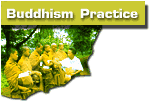 |
BANGKOK
|
||||||||
CENTRAL
|
||||||||||||
NORTHEASTERN
|
||||||||||||||
NORTHERN
|
||||||||||||
SOUTHERN
|
||||
 |
| A GUIDE TO MEDITATION CENTRES IN THAILAND |
| CENTRAL - WAT SAI NGAM |
MEANING
OF NAME : |
"Temple of beautiful banyan trees" |
ALSO
SPELLED : |
Wat Trai Ngarm |
ADDRESS
: |
Tambon Donmasang, Amper Muang, Supanburi 72000 |
DIRECTIONS
: |
From Bangkok, take a bus from the Northern (Moh Chit) Bus Terminal to Supanburi, 100 km to the northwest, then take a local bus northeast 15 km on the road to Ang Thong. The wat is 0.5 km in. |
TELEPHONE
: |
0-3552-2005 |
MEDITATION
SYSTEM : |
Ajahn Dhammadharo developed a vipassana technique using hand movements that gave good results in his practice. After 9 years of using this method, he felt confident in teaching it to others. Sitting meditation typically begins with some metta practice (benefits include helping to clear the mind of hindrances) followed by anapansati (to calm the mind). One then begins the prescribed hand and finger movements, using either arm, while directing attention to the palm or fingers. Sensations arising in the hand, then extending along the arm to the chest, back, and head are used in development of clear comprehension leading to penetrating insight. Touch-point sensations are used too. The meditation system instructions have been translated into English in the book The Manual of Insight Meditation; Practising Clear Comprehension in Accordance with the Maha Satipatthana Sutta by Pannavuddho Bhikkhu; this book should be available at the wat. |
TEACHING
METHOD : |
Lectures (occasionally by Ajahn Dhammadharo) and by asking questions. Books and tapes in Thai can be purchased, as can the English book by Pannavuddho. |
TEACHERS
: |
Ajahn Dhammadharo, abbot (Thai; age 78) assisted by senior monks. |
LANGUAGE
: |
One should speak good Thai in order to take advantage of the teachings here. Some monks and nuns can speak a little English. |
DESCRIPTION
: |
A large temple of 70 rai (28 acres) surrounded by rice fields. Trees shade the central area. On arrival at the main entrance, you'll find the office in the raised building on the left just past the abbot's house; the large sala ahead, also on stilts, is used for eating and meditation; turn left at the junction and follow the path for the bot . exceptionally beautiful even by high Thai standards. The Buddha image inside sits in a teaching pose under a large artificial tree. |
SIZE
: |
monks
150-200 novices 15-20 nuns 80-100 laymen about 10 laywomen 20-30 |
DAILY
ROUTINE : |
4
a.m. chanting in "bat"; 5 a.m. monks and novices leave for pindabat by bus; 8 a.m. first meal; 11 a.m. second meal; 2-4 p.m. sitting and standing meditation; 4-5 p.m. walking meditation; 5 p.m. drink; 6.30 p.m. sitting and standing meditation; 8 p.m. lecture; 9-10 p.m. walking meditation. |
FOOD
: |
Good quality and variety. Monks and novices take a temple bus to Supanburi, Ang Thong, or other nearby town for pindabat; laypeople are welcome to come along and help collect food. Two meals in morning; nuns and laypeople eat after monks and novices. |
ACCOMMODATIONS
: |
Monks and novices stay in individual kutis of stone or wood; fairly close together. All have electricity and running water; newer kutis have Thai-style bathrooms. Laymen have shared rooms or dormitories; nuns and laywomen usually share rooms. |
WRITE
IN ADVANCE? : |
Not necessary. |
OTHER
INFORMATION : |
Ajahn Dhammadharo began teaching about 1954. His first center was Wat Chai Na (Wat Tow Kote) in Nakhon Sri Thammarat Province in the south. In the 1970s he moved to his home province and founded Wat Sai Ngam. Discipline is left mostly to the individual. Laypeople observe 8 precepts and wear white; they also wear a white sash over their shoulder. The sash ( pah sabay chieng ) can be purchased in the temple shop. Unless entering or leaving the temple grounds, residents walk barefoot everywhere. |
| Select here : |
|
|